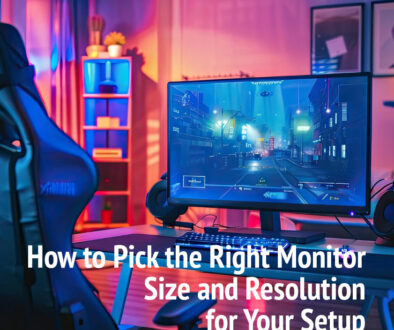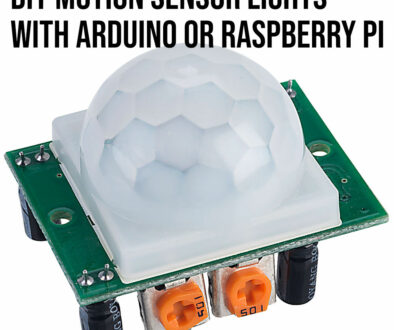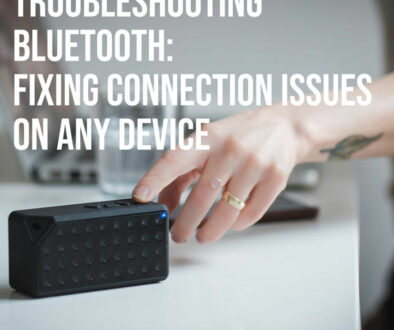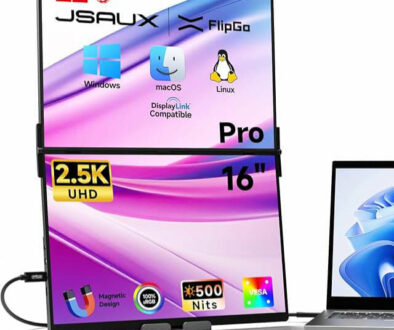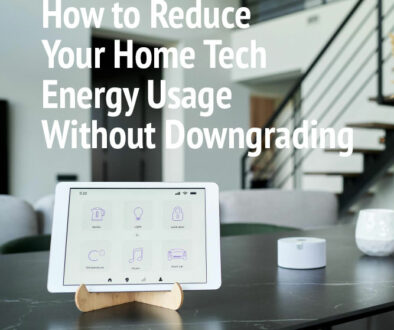Best Gadgets and Appliances to Run on a Portable Power Station
Portable power stations have become an essential tool for modern living, providing on-demand electricity for homes, outdoor adventures, and emergency preparedness. Whether you need a backup power source during outages, a reliable way to charge devices off-grid, or a portable energy solution for travel, choosing the right gadgets and appliances can make a significant difference in power efficiency and battery longevity.
Not all devices are suited for battery-powered operation—some drain energy too quickly, while others run efficiently on minimal wattage. Understanding power consumption, wattage limits, and priority usage will help you maximise the performance of your power station. In this guide, we’ll explore the best gadgets and appliances to run on a portable power station, ensuring you get the most out of your energy supply.
Understanding Wattage and Power Consumption
Before connecting any device to a portable power station, it’s crucial to understand wattage and power consumption. Every appliance or gadget requires a certain amount of power (watts, W) to operate continuously and, in some cases, additional power to start up (surge power). Portable power stations are rated in watt-hours (Wh), which determines how long they can run a device before needing a recharge.
For example, a 500Wh power station can theoretically run a 50W device for 10 hours (500Wh ÷ 50W = 10 hours). However, power conversion losses and battery efficiency mean the actual runtime is often lower. To ensure you’re using your power station efficiently:
- Check device wattage labels before plugging them in.
- Prioritise energy-efficient gadgets with lower watt consumption.
- Balance high-power and low-power devices to avoid draining the battery too quickly.
A smartphone charger (10W) can run for days on a mid-sized power station, whereas a microwave (1000W+) can drain the battery in under an hour. Choosing the right appliances ensures longer battery life and improved efficiency.

Essential Low-Power Devices for Everyday Use (Best for Small Power Stations – under 300W)
For most daily needs, low-power gadgets are ideal for running on a portable power station. These devices consume minimal electricity, allowing you to maximize battery life and runtime.
1. Smartphones & Tablets (5-20W)
One of the most common uses for a power station is charging mobile devices. A fully charged 500Wh power station can recharge a smartphone over 40 times or a tablet 15-20 times before running out of power. Most modern power stations feature USB-A and USB-C ports, making charging even more efficient.
Example: A 10,000mAh smartphone battery (typically around 10W per charge) will barely impact the capacity of a 500Wh power station.

2. Laptops (30-90W)
A laptop is a mid-range power consumer that can run efficiently on a portable power station. Most ultrabooks consume 30-50W, while high-performance gaming laptops require 70-90W or more. If you need backup power for remote work or travel, a 300Wh power station can charge a laptop 4-6 times before needing a recharge.
Example: A MacBook Air (30W) can run for 15+ hours on a 500Wh station, while a high-power gaming laptop (90W) would last around 5-6 hours.

3. WiFi Router & Modem (5-15W)
Keeping an internet connection active during power outages is a top priority for many households. A WiFi router and modem combo typically consumes 5-15W, making it highly efficient for portable power stations. A 300Wh station can keep the internet running for up to 24-48 hours.
Example: A Netgear Nighthawk router (12W) can run for 40+ hours on a 500Wh station.

4. LED Lights (5-15W)
LED bulbs are one of the best power-efficient lighting solutions, making them perfect for off-grid camping, home emergencies, or outdoor activities. Since they consume as little as 5W per bulb, a single 500Wh power station could keep multiple LED lights running for days.
Example: A 10W LED bulb could run for 50 hours on a 500Wh power station.

5. Rechargeable Batteries & Power Banks (10-30W)
Using a power station to charge a secondary power bank or AA/AAA rechargeable batteries is an excellent way to extend power availability. A fully charged 20,000mAh power bank can provide multiple smartphone charges before needing a recharge itself.
Example: Charging an Anker PowerCore 26800mAh power bank (30W) on a 500Wh station uses less than 10% of its total capacity.

6. USB Desk Fan (with or without built-in battery) (5-15W)
A USB-powered desk fan is a great low-energy cooling solution for home offices, bedside tables, and workstations. These fans consume as little as 5W, making them extremely efficient for portable power stations. Many models include a built-in battery, allowing them to run without continuous power input, extending battery life further.
Example: The SmartDevil USB Desk Fan (5W) can run for 100 hours on a 500Wh power station, while a larger battery-powered model (15W) could run for 30+ hours on the same charge.

7. Big Outdoor Fan (with built-in battery) (30-100W)
For outdoor events, garages, patios, and camping trips, a large battery-powered fan provides excellent air circulation without excessive power drain. Unlike USB fans, these high-airflow models often include rechargeable lithium-ion batteries, allowing them to operate for several hours without external power. When plugged into a 500Wh power station, they can run for extended periods.
Example: The Geek Aire 16” Rechargeable Outdoor Fan (40W) or equivalent can run for up to 32 hours at low speed or 4 hours at max speed on its built-in 20,000mAh battery.

8. Low Power Desktop Computer (20W to 65W) and Portable Monitor
A low-power desktop computer paired with a portable monitor is an excellent choice for remote work, digital nomads, and energy-efficient computing. Many modern desktops are designed to consume far less power than traditional towers, making them ideal for power stations.
Apple Mac Mini M2/M4 (30-40W) – Apple’s latest Mac Mini M4 (30W typical load, 60W max) is an ultra-efficient desktop, capable of running for 12-16 hours on a 500Wh power station.

PC Equivalent – Intel NUC 13 Pro (20-65W) – The Intel NUC 13 Pro (25W base, 65W max) offers compact, energy-efficient PC performance, lasting 6-20 hours depending on load.

Portable Monitor (5-15W) – A 15.6” USB-C portable monitor uses 5-15W, adding minimal energy demand.
Example: A Mac Mini M4 (30W) + a 10W portable monitor would last 12+ hours on a 500Wh power station, making it a great off-grid workstation setup.
9. USB-Powered Desk Lamp (with or without built-in battery) (3-10W)
A USB-powered desk lamp is a great low-energy lighting solution for reading, studying, or nighttime use. Many models include dimmable LED bulbs and adjustable brightness settings, allowing you to optimize power usage. Battery-powered models offer additional flexibility, running without needing to be continuously plugged in. These can be charged up by the power station to top up its battery for use in the evening.
Since LEDs consume very little power, a USB lamp using 3-10W can run for 50+ hours on a 500Wh power station, making it one of the most energy-efficient lighting solutions.
Example: The BenQ e-Reading LED Desk Lamp (10W) can run for 50 hours on a 500Wh power station, while a 3W minimalist USB lamp could last over 150 hours on the same charge.

10. Electric Lunch Box / Portable Food Warmer (40-60W)
A portable electric lunch box or food warmer is a convenient way to heat meals without relying on a microwave, making it perfect for offices, travel, or camping. These devices consume significantly less power than standard microwaves, typically running at 40-60W, allowing for energy-efficient food heating.
Most heat food in 20-30 minutes, meaning they use relatively little battery power compared to larger appliances. They are especially useful for truck drivers, campers, and remote workers who need a warm meal but don’t have access to full kitchen facilities.
Example: The HotLogic Mini Portable Oven (45W) can warm a meal in about 30 minutes, consuming only 22.5Wh per use, allowing for over 20 meals on a single charge of a 500Wh power station.

Why Low-Power Devices Are Ideal
Low-wattage gadgets are the most efficient use of portable power stations, offering longer runtimes and better energy management. When using a small (under 300Wh) or mid-sized power station (under 500Wh), prioritising these energy-efficient devices ensures you get the most out of every charge.
Medium-Power Gadgets for Home and Travel (Best for Mid-Capacity Power Stations – 300W to 1000W)
For those using mid-sized power stations (300Wh to 1000Wh), a wider range of medium-power devices can be supported. These include appliances that require moderate wattage but still remain energy-efficient. While they consume more power than low-wattage devices, they are still practical for short-term use.
1. Mini Fridges (60-100W)
A mini fridge is an excellent addition for camping trips, RV travel, or emergency food storage during a power outage. Since most mini fridges consume around 60-100W, a 500Wh power station can run one for 5-8 hours before requiring a recharge. However, power draw may vary based on temperature settings and frequency of door openings.
Example: A Cooluli Mini Fridge (55W) can run for 9 hours on a 500Wh station, while a larger compact fridge (100W) lasts 5 hours.

These low power fridges can also be powered by 12V output that are typically available on Power Stations currently in the market like the VTOMAN below.

2. CPAP Machines & Medical Devices (30-100W)
For individuals who rely on CPAP machines for sleep apnea or other medical devices, having a portable power station as a backup can be life-saving. Most CPAP machines use 30-100W depending on settings like humidification and pressure levels. Using a power station without the humidifier can significantly extend battery life.
Example: A ResMed AirSense 10 CPAP (90W with humidifier, 40W without) can run for 12 hours without humidifier on a 500Wh power station.

3. Portable Fans (20-50W)
In warm climates or during power outages, a small portable fan can provide essential cooling. Most energy-efficient models consume 20-50W, meaning a 500Wh power station can run a fan for 10-20 hours before depleting.
Example: A Honeywell HT900 Fan (40W) can run for 12 hours on a 500Wh power station.

4. TVs & Streaming Devices (50-200W)
For entertainment during power outages or off-grid trips, a television and streaming device can be powered with a mid-capacity power station. Energy-efficient LED TVs consume less than 100W, while older or larger models may require up to 200W.
Example: A 32-inch LED TV (50W) + Fire TV Stick (5W) can run for 9+ hours on a 500Wh power station.

5. Electric Blankets & Heated Pads (50-150W)
During cold weather, an electric blanket or heating pad can provide warmth without the extreme power drain of a space heater. Low-wattage electric blankets consume 50-100W, making them viable for short-term heating solutions.
Example: A Sunbeam Electric Blanket (100W) can run for 5 hours on a 500Wh power station.

Why Medium-Power Devices Are Useful
While medium-power devices consume more electricity than low-power gadgets, they are still manageable on mid-range power stations for shorter durations. If paired with solar panels for recharging, these devices can provide a more sustainable off-grid power solution.
High-Power Appliances for Home Backup & Off-Grid Living (Best for High-Capacity Power Stations – 1000W and above)
For those with high-capacity portable power stations (1000Wh and above), it is possible to run power-hungry appliances. However, since these devices consume significant wattage, they should be used sparingly and strategically to avoid rapidly depleting battery life.
1. Microwaves (600-1200W)
A microwave is one of the highest-consuming appliances that can run on a large-capacity power station. While they require high wattage, they are used for short bursts, making them practical for brief food heating needs.
Example: A 700W microwave can run for 40 minutes on a 1000Wh power station.

2. Coffee Makers (600-1000W)
Coffee lovers can use a power station to brew coffee, but high-wattage models can quickly drain battery life. Drip coffee makers and espresso machines range from 600-1000W, meaning they should be used only when necessary.
Example: A Keurig K-Express (750W, 3 minutes per brew) will consume around 37Wh per cup, allowing for 27 brews on a 1000Wh station.

3. Electric Kettles (800-1500W)
Electric kettles boil water quickly, but they also consume a lot of power. If you need hot water for tea, cooking, or sanitisation, it’s best to boil in small amounts to preserve battery life.
Example: A 1000W electric kettle boiling 1 liter of water will consume about 10% of a 1000Wh power station’s capacity. Smaller kettles with 0.8ml capacity can have a maximum power output of 600W and 800W. Less water means quicker boiling time and more efficient on the battery.
4. Hair Dryers (800-1800W)
Hair dryers are extremely power-intensive and can quickly deplete a battery if used at full power. Some models have lower-wattage settings (600-800W) that may be suitable for portable power use.
Example: A 1200W hair dryer running for 5 minutes will consume 100Wh, meaning a 1000Wh power station could power it for about 50 minutes total.

5. Induction Cooktops (1000-2000W)
For those living off-grid or in RVs, an induction cooktop is a convenient way to cook meals without propane. However, it consumes high wattage and should be used only when absolutely necessary.
Example: A 1500W cooktop running for 30 minutes will use 750Wh, draining most mid-sized power stations quickly.

Why High-Power Appliances Require Caution
Running high-wattage appliances on a portable power station can rapidly deplete battery reserves, making them impractical for extended use unless the station is recharged frequently (e.g., via solar panels or a backup generator). If using these devices, strategic energy management is essential.
Gadgets to Avoid Running on a Portable Power Station
While portable power stations can handle a wide range of devices, some appliances are too power-hungry to be practical. These devices drain batteries rapidly, making them unsuitable unless connected to an extremely large-capacity power station or a hybrid solar system.
1. Air Conditioners (1000-3500W)
Air conditioners are among the most energy-intensive appliances, often requiring high surge power at startup. Even small portable AC units consume over 1000W, meaning a 1000Wh power station would last less than an hour. Running an AC is only feasible with a gas generator or solar-powered hybrid system.
Example: A Midea 8000 BTU portable AC (1100W) would drain a 1000Wh power station in about 50 minutes.

2. Space Heaters (1000-2500W)
Electric space heaters are extremely inefficient for battery-powered use. Even a small 1000W heater would drain a 1000Wh power station in just one hour. Instead, opt for low-power heating alternatives like heated blankets (50-100W).
Example: A Dyson Hot+Cool Heater (1500W) would last 40 minutes on a 1000Wh power station.

3. Large Refrigerators (500-800W)
While mini fridges are manageable, full-size refrigerators require continuous power to maintain temperature, making them impractical for most portable power stations. If emergency refrigeration is needed, consider using a cooler with ice packs or a solar-powered fridge.
Example: A standard kitchen fridge (600W) would fully drain a 1000Wh power station in under 2 hours.
4. Washing Machines & Dryers (1000-3000W)
Laundry appliances consume large amounts of energy, especially dryers. While some compact washing machines use less power (200-500W), they still require a high-capacity power station and are better suited for grid or solar-powered setups.
Example: A standard washing machine (1200W) would last under an hour on a 1000Wh power station.
Why These Devices Are Not Practical
High-wattage appliances are best suited for traditional electrical grids, gas generators, or whole-home battery backup systems. Running them on portable power stations results in quick battery depletion, making them impractical for sustained use.
If you would like more tips for maximising your power station’s efficiency check out How to Make the Most of Your Portable Battery Power Station.
Final Thoughts
A portable battery power station is an incredibly useful tool for emergency backup, off-grid power, and outdoor use. However, choosing the right devices to run on it is essential for maximising efficiency and runtime.
- Low-power gadgets like smartphones, laptops, WiFi routers, and LED lights are the best choices for small to mid-sized power stations.
- Medium-power appliances, including mini fridges, CPAP machines, and TVs, can be used with mid-sized power stations but require power management.
- High-wattage devices, such as microwaves, coffee makers, and induction cooktops, require large-capacity power stations and should be used sparingly.
- Some appliances, like air conditioners, space heaters, and full-size refrigerators, are too power-hungry for most portable battery stations and should be avoided.
By choosing energy-efficient gadgets, rotating device usage, and utilising solar recharging, you can get the most out of your power station. Whether for home backup, camping, or off-grid living, knowing how to manage power effectively will ensure you always have electricity when you need it most. Finally, we leave you with a checklist for the best gadgets and appliances for portable power station.
Checklist: Best Gadgets & Appliances for Portable Power Stations
Best Low-Power Devices (Under 300W) – Ideal for Small Power Stations
- Smartphones & Tablets (5-20W) – Charge 40+ times on a 500Wh station
- Laptops (30-90W) – Ideal for remote work, lasts 5-10 hours per charge
- WiFi Router & Modem (5-15W) – Keeps internet running for up to 48 hours
- LED Lights (5-15W) – Long-lasting emergency lighting
- Rechargeable Batteries & Power Banks (10-30W) – Store extra power for later
Medium-Power Gadgets (300W-1000W) – Requires Mid-Sized Power Station
- Mini Fridges (60-100W) – Runs for 6-8 hours on a 500Wh station
- CPAP Machines (30-100W) – Essential for medical needs; longer life without humidifier
- Portable Fans (20-50W) – Energy-efficient cooling
- TVs & Streaming Devices (50-200W) – Limited entertainment use during outages
- Electric Blankets (50-150W) – Low-energy alternative to space heaters
High-Power Appliances (1000W+) – Only for Large-Capacity Power Stations
- Microwaves (600-1200W) – Drains a 1000Wh station in 40-60 minutes
- Coffee Makers (600-1000W) – Manageable but should be used sparingly
- Induction Cooktops (1000-2000W) – Rapid battery depletion; best for short use
- Hair Dryers (800-1800W) – Limited runtime, should be avoided if possible
Gadgets to Avoid Running on a Portable Power Station
🚫 Air Conditioners (1000-3500W) – Too energy-intensive for most power stations
🚫 Space Heaters (1000-2500W) – Drains battery in under an hour
🚫 Large Refrigerators (500-800W) – Continuous power draw makes them impractical
🚫 Washing Machines & Dryers (1000-3000W) – Require too much energy for battery power
Tips for Maximising Power Efficiency
- Prioritise energy-efficient devices – Use LED lights, low-power fans, and small fridges
- Use energy-saving settings – Lower laptop brightness, Eco mode on TVs
- Rotate device usage – Don’t run high-wattage appliances all at once
- Consider solar charging – A 100W solar panel can recharge mid-sized power stations
- Avoid deep discharges – Keep battery levels between 20-80% to extend lifespan
By following this checklist, you can optimise your portable power station for emergency use, off-grid adventures, and home backup power without unnecessary battery drain.

















